15 Plants You Shouldn't Bother Deadheading
Spend more time enjoying the garden and less time pruning with these low-maintenance flowering plants.

Ralph Lee Anderson
Savvy gardeners know that deadheading spent blooms keeps annuals and many perennial plants looking their best week after week. But not all plants require deadheading. Some plants continue to bloom their hearts out with little to no pruning, while others are self-cleaning, meaning spent flowers drop off naturally by means of wind, rain, or plant growth. These plants keep on blooming even when you don’t remove the old flowers. If you’re looking to save time in the garden, consider growing plants that don’t require deadheading to stay in bloom.
Some plants perform best when spent blooms are left in place. Many annuals and perennials reseed in the garden, replacing themselves or slowly spreading to cover more ground. Leaving the faded flowers on these plants will ensure seeds develop to nurture the next generation of blooms. Then there are plants that continue to shine even as their blossoms fade. They may produce gorgeous seed heads like sedums, or dry in place like hydrangeas. Here are a few plants that you need not bother deadheading.
Related: Everything You Need To Know About How To Deadhead Flowers
Angelonia
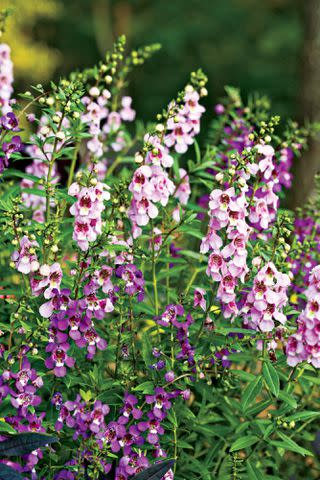
Botanical Name: Angelonia angustifolia
Sun Exposure: Full Sun
Soil Type: Medium to Moist, Well-draining, Rich
Soil pH: Mildly Acidic to Neutral (5.5-6.8)
Blooming in white, blue, pink, and purple hues, Angelonia is known for its long summer bloom period. The two-lipped flowers resemble snapdragons and are self-cleaning, providing months of blooms with little work. Perfect for containers or massing in sunny beds and borders.
Columbine
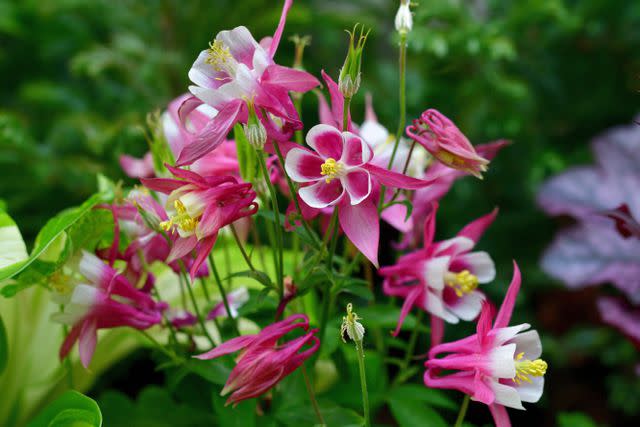
Getty Images
Botanical Name: Aquilegia canadensis
Sun Exposure: Full Sun to Part Shade
Soil Type: Medium Moisture, Well-draining, Average Fertility
Soil pH: Mildly Acidic to Slightly Alkaline (6.0-8.0)
This woodland wildflower is adored for its unique blooms. The tubular red and yellow flowers are a favorite of hummingbirds, providing an early source of nectar. Columbine reseeds readily in the garden, with new plants blooming in their second year. Naturalize columbine in woodland or native gardens and plant as a lush ground layer in shady borders.
Hydrangeas

Southern Living/Vlasova Evgeniya
Botanical Name: Hydrangea spp. and cultivars
Sun Exposure: Full Sun to Part Shade
Soil Type: Medium Moisture, Well-draining, Rich
Soil pH: Acidic to Neutral (5.2-7.5)
Most hydrangeas do not require deadheading and will not rebloom if you remove spent blooms. The exception to this rule is reblooming varieties such as Endless Summer? and 'White Wedding', which bloom on both old and new growth. Reblooming varieties should be deadheaded after the initial spring or early summer bloom. You can skip deadheading other hydrangeas and enjoy the spent flower heads instead, which are often quite beautiful, adding texture and fall color to the garden.
Supertunia? Petunias

Proven Winners
Botanical Name: Petunia hybrid
Sun Exposure: Full to Part Sun
Soil Type: Medium to Moist, Well-draining, Average Fertility
Soil pH: Acidic to Neutral (5.5-7.0)
With their sticky foliage and stems, petunias have never been an enjoyable plant to deadhead. The Supertunia? petunias make this tiresome chore a thing of the past. Plants are sterile and self-cleaning, so you get non-stop blooms in a range of vibrant hues without all the messy pinching.
Sedum
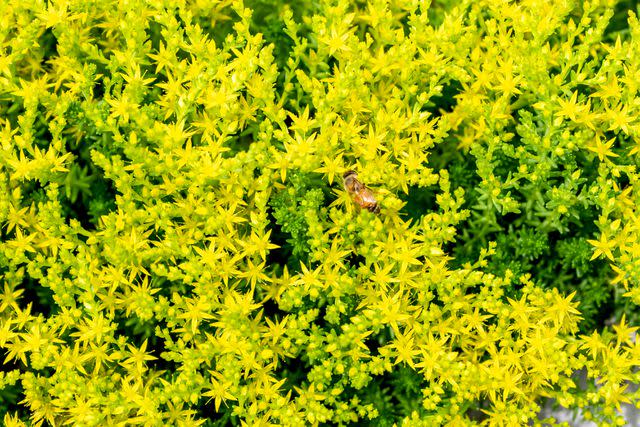
Southern Living/Adrienne Legault
Botanical Name: Hylotelephium spp. and hybrids
Sun Exposure: Full Sun
Soil Type: Dry to Medium, Well-draining, Average Fertility
Soil pH: Mildly Acidic to Neutral (6.0-7.5)
Sedums produce a single flush of blooms in summer or fall and deadheading does not promote reblooming. The vibrant flowers are adored by butterflies and other pollinators and last for several weeks in the garden. As the seeds mature, the flower heads remain attractive, taking on darker hues and drawing hungry songbirds to the garden, including finches, grosbeaks, and chickadees.
Love-in-a-Mist

Getty Images / Jacky Parker Photography
Botanical Name: Nigella damascena
Sun Exposure: Full Sun
Soil Type: Medium Moisture, Well-draining, Average Fertility
Soil pH: Mildly Acidic to Neutral (6.0-7.0)
The flowers of Love-in-a-Mist look like ballerina’s skirts twirling in the breeze. Blooming in blue, white, pink, or rosy-purple hues, the graceful blooms stand atop thread-like foliage and are followed by unique, balloon-shaped seed pods shrouded in lacy foliage. The seed heads are as dramatic as the blooms, if not more so. This plant is a prolific self-sower, another reason to leave those stunning seedpods standing.
Bidens

Getty Images
Botanical Name: Bidens spp. and hybrids
Sun Exposure: Full to Part Sun
Soil Type: Medium Moisture, Well-draining, Average Fertility
Soil pH: Acidic (5.5-6.3)
Bidens are robust plants, producing flush upon flush of cheerful yellow or orange blooms. The new flowers hide old, spent blooms which eventually drop their petals, so there is no need to deadhead. Bidens self-sow under good growing conditions, however hybrid varieties will not return true to type.
Baptisia

Botanical Name: Baptisia spp.
Sun Exposure: Full Sun to Part Shade
Soil Type: Dry to Medium, Well-draining, Average Fertility
Soil pH: Mildly Acidic to Neutral (6.0-7.2)
Baptisia are tough prairie plants with a graceful appearance and showy blooms. Flowers are followed by inflated seed pods that turn black as they ripen and dry. Stems holding seed pods are popular for dried flower arrangements. The seeds are loose and clatter around inside the pods, giving baptisia the name rattleweed, as children once used the seedpods as rattles.
Alliums
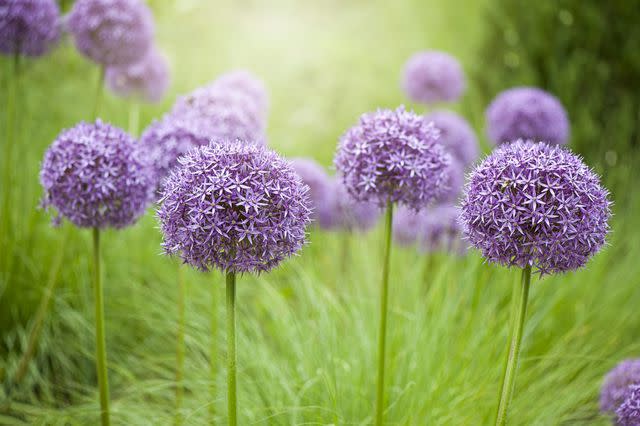
Botanical Name: Allium spp. and hybrids
Sun Exposure: Full Sun
Soil Type: Dry to Medium, Well-draining, Average Fertility
Soil pH: Mildly Acidic to Neutral (6.0-7.0)
Ornamental onions or alliums add a punch of color to the garden and serve as an interesting upright element. As flowers fade, the seed heads often take on a spiky appearance, which provide long-lasting texture and structure to the garden. Watch for birds feeding on the seed heads in autumn.
Foxglove

Botanical Name: Digitalis purpurea
Sun Exposure: Full Sun to Part Shade
Soil Type: Medium Moisture, Well-draining, Average Fertility
Soil pH: Acidic to Neutral (5.5-7.0)
Foxgloves are a beloved biennial with spikes of tubular flowers blooming in blushing pink and purple tints. Plants produce a basal rosette of downy foliage in their first year and flower in the second season, after which the plants typically die out. To maintain a persistent patch of foxgloves, avoid deadheading and allow plants to set seed after flowering.
Calibrachoa

Getty Images
Botanical Name: Calibrachoa x hybrida
Sun Exposure: Full Sun to Part Shade
Soil Type: Moist, Well-draining, Rich
Soil pH: Acidic (5.0-6.5)
Aptly nicknamed million bells, these trailing beauties produce masses of colorful blooms that cover plants from spring through frost. Best of all, the plant is self-cleaning so there is no need to deadhead spent flowers to keep those blooms coming. Flowering in almost every color of the rainbow, the bright blooms attract hummingbirds to the garden.
Hollyhock

Botanical Name: Alcea rosea
Sun Exposure: Full Sun to Part Shade
Soil Type: Well-draining, Rich
Soil pH: Mildly Acidic to Slightly Alkaline (6.0-8.0)
Hollyhocks tower over perennial beds and borders, adding cottage charm to any planting. Like foxglove, hollyhocks typically grow as biennials, growing a rosette of foliage in their first season and producing flowers in their second year. They reseed readily in the garden for a continuous stand of cheery blooms. Sow seeds two years in a row and you’ll have plants flowering every season.
Cleome
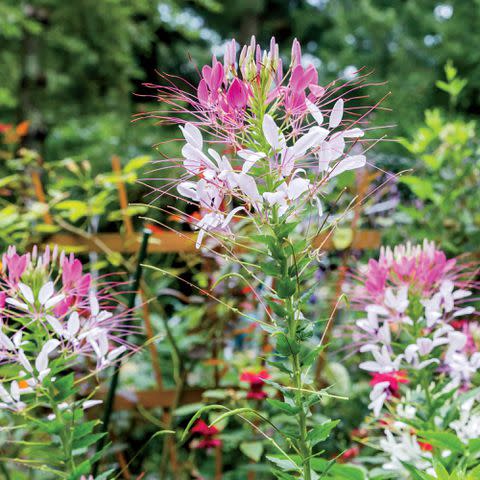
Botanical Name: Cleome spp. and hybrids
Sun Exposure: Full Sun to Part Shade
Soil Type: Dry to Medium, Well-draining, Average Fertility
Soil pH: Mildly Acidic to Neutral (6.0-7.5)
Commonly known as spider flower or bee plant, cleome is a fast-growing annual or tender perennial that flowers from early summer through fall. The tall flower spikes continuously add blooms to the tips of their elongating stems, replacing old flowers with new ones. As such, there is no need for deadheading spent blooms. The old flowers give way to long, thin seedpods that add texture and interest to the blooms. With the exception of newer sterile cultivars, cleomes readily reseed in the garden.
Dwarf Morning Glory

Getty Images
Botanical Name: Evolvulus spp. and hybrids
Sun Exposure: Full Sun
Soil Type: Medium Moisture, Well-draining, Average Fertility
Soil pH: Mildly Acidic to Neutral (6.0-7.2)
With true blue flowers and silvery foliage, dwarf morning glory looks stunning spilling out of containers or scrambling along the garden floor. Plants are self-cleaning, producing an endless supply of vibrant blooms. Flowers close at night and on cloudy days, opening again come morning.
Cardinal Flower

Botanical Name: Lobelia cardinalis
Sun Exposure: Full Sun to Part Shade
Soil Type: Medium to Moist, Well-draining, Rich
Soil pH: Acidic to Neutral (5.5-7.5)
Despite their name, cardinal flowers do not attract the eponymous bird, instead their cardinal red blooms draw in scores of hummingbirds and butterflies. Cardinal flower blooms mid to late summer, with flowers opening sequentially along tall spikes, beginning at the bottom and working toward the tip. As such, there is no need to deadhead spent blooms.
For more Southern Living news, make sure to sign up for our newsletter!
Read the original article on Southern Living.
